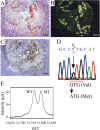Recent advances in transthyretin amyloidosis therapy
- PMID: 25228988
- PMCID: PMC4165622
- DOI: 10.1186/2047-9158-3-19
Recent advances in transthyretin amyloidosis therapy
Abstract
Mutant (MT) forms of transthyretin (TTR) cause the most common type of autosomal-dominant hereditary systemic amyloidosis-familial amyloidotic polyneuropathy (FAP). Until 20 years ago, FAP was thought to be an endemic disease, but FAP is known to occur worldwide. To date, more than 130 mutations in the TTR gene have been reported. Genotype-phenotype correlations are seen in FAP, and some variation in clinical presentation is often observed in individual kindreds with the same mutation and even among family members. Of the pathogenic TTR mutations, Val30Met was the first to be identified and is the most frequent known mutation found throughout the world. Studies of patients with FAP amyloidogenic TTR (ATTR) Val30Met documented sensorimotor polyneuropathy, autonomic dysfunction, heart and kidney failure, gastrointestinal tract (GI) disorders, and other symptoms leading to death, usually within 10 years of the onset of disease. Diagnosis is sometimes delayed, especially in patients without a clear family history and typical clinical manifestations, since diagnosis requires various studies and techniques such as histopathology, genetic testing, and mass spectrometry. For treatment of FAP, liver transplantation (LT) reportedly halts the progression of clinical manifestations. Exchange of an FAP patient's diseased liver with a healthy liver causes MT TTR in the body to be replaced by wild-type (WT) TTR. Although clinical evaluations indicated that progression of other clinical symptoms such as peripheral neuropathy, GI symptoms, and renal involvement usually halted after LT in FAP ATTR Val30Met patients, recent studies suggested that LT failed to prevent progression of cardiac amyloidosis in FAP ATTR Val30Met patients after LT, with this failure reportedly being due to continued formation of amyloid that derived mainly from WT TTR secreted from the transplanted non-mutant liver graft. In recent years, many therapeutic strategies have been proposed, and several ongoing therapeutic trials involve, for example, stabilizers of TTR tetramers (tafamidis and diflunisal) and gene therapies to suppress TTR expression (antisense methods and use of small interfering RNAs). These novel therapies may prove to prevent progression of FAP.
Keywords: Amyloidosis; Familial amyloidotic polyneuropathy; Gene therapy; Immunotherapy; Senile systemic amyloidosis; Transthyretin.
Figures




References
-
- Ando Y, Nakamura M, Araki S. Transthyretin-related familial amyloidotic polyneuropathy. Arch Neurol. 2005;62:1057–1062. - PubMed
-
- Zeldenrust S, Benson MD. In: Protein Misfolding Diseases: Current and Emerging Principles and Therapies. Alvarado M, Kelly JW, Dobson CM, editor. Hoboken, NJ: John Wiley & Sons; 2010. Familial and senile amyloidosis caused by transthyretin; pp. 795–815.
-
- Planté-Bordeneuve V, Said G. Familial amyloid polyneuropathy. Lancet Neurol. 2011;10:1086–1097. - PubMed
-
- Ando Y, Ueda M. Diagnosis and therapeutic approaches to transthyretin amyloidosis. Curr Med Chem. 2012;19:2312–2323. - PubMed
-
- Ando Y. Liver transplantation and new therapeutic approaches for familial amyloidotic polyneuropathy (FAP) Med Mol Morphol. 2005;38:142–154. - PubMed
Publication types
LinkOut - more resources
Full Text Sources
Other Literature Sources
Research Materials
Miscellaneous

